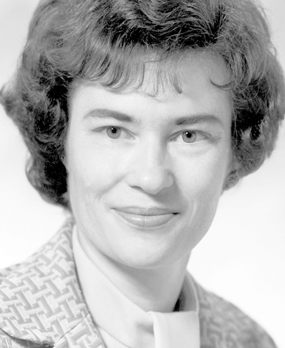Patsy O'Connell Sherman:
How she has transformed the scene
Innovative thinking turns accident into opportunity
Many of today's most well-known inventions were simply mistakes made by scientists on an alternative quest. Such is the case with a household name created by 3M chemist Patsy Sherman: Scotchgard™.
Sherman was assigned to develop a rubber material that would resist deterioration from jet aircraft fuels. One day in 1953, a lab assistant spilled some of Sherman's chemicals on her new white canvas tennis shoes. Nothing worked to clean off the drops. While the rest of the shoe became dirty and stained, one spot remained clean. Sherman and fellow 3M chemist Samuel Smith saw an opportunity, and several years later, nailed down an application for that accidental spill — the development of a fluorochemical polymer that could repel oil and water from fabrics. This invention became known as Scotchgard™.
Eventually 3M would have about 40 products in the Scotchgard™ family, with Sherman holding 16 U.S. patents, sharing 13 of those with Smith. Another one of Sherman's patents is for the first "optical brightener" that let detergent makers brag their soap-washed clothes were "whiter than white."
Stubbornness leads to career in science
Sherman was born Patsy O'Connell on Sept. 15, 1930. In high school during the late 1940s, Sherman refused to accept the results of an aptitude test for girls that indicated her best career choice was "housewife." She wanted a career and didn't want to spend her time studying in college only to end up at home. She insisted she be allowed to take the test given to boys, which indicated she should be a dentist or scientist.
A career in science intrigued her. Sherman graduated in 1948 from Minneapolis North High School. In 1952, she became the first female to graduate with a B.S. in chemistry and mathematics from Gustavus Adolphus College in St. Peter, Minn. She took a "temporary" job at 3M, working on a contract to develop new fuel lines for jet aircraft using fluorochemicals. Women hired to do laboratory work in those days were considered temporary employees because it was assumed they'd get married, have children and leave. Sherman did marry (her husband, Hubert, died in 1996) and have children, but she ended up working her entire career for 3M, becoming manager of technical development and retiring in 1992. Sherman was the first woman inducted into 3M's prestigious Carlton Society in 1974, which honors the company's top scientists. She was named to the Minnesota Inventors Hall of Fame in 1989 and to the National Inventors Hall of Fame in 2001.
Sherman received many other honors during her career.
- In 1975, she became a Distinguished Alumni Citation Recipient for Scientific Research.
- Sherman was a member of the American Chemical Society for over 50 years.
- The American Society for Engineering Education honored her with the Joseph M. Biedenbach Distinguished Service Award in 1991.
- She was one of 37 inventors asked to speak at the United States Patent and Trademark Offices 200th birthday celebration in 2002.
- Her invention of Scotchgard™ is considered one of the top 15 accidental inventions.
Sherman died on Feb. 11, 2008 at age 77. Her love of science lives on in both of her daughters, who also chose careers in science: Sharilyn is a 3M chemist and Wendy is a biologist who owns a precision optics company.
The area of fluorochemistry has received a lot of concern in the last two decades. In 2000, 3M announced it would phase out the use of perfluorochemicals (PFCs), formerly used in Scotchgard™ and other products. 3M still sells Scotchgard™ using a different formula.

